-->This past summer Angie and I engaged in all of the things listed above (we
also got engaged).
Whenever I tell people that I teach in Alaska usually one of the first things out
of their mouths is a variation of “Oh I’ve heard Alaska is so beautiful!”
My response has been, “I’ve heard good
things.”
To be fair, western Alaska
is nice to look at.
The gradual transition to fall with the
various tundra plants changing from deep green to oranges and reds and finally
to a very fall-like brown does attract my attention when the sun is shining and
the winds are calm.
But the gentle
subtlety of the tundra is not what the people I’ve talked to have in mind.
They picture eye-popping mountain vistas.
They see calving glaciers splashing to the
sea.
Above it all the bald eagle
surveying the scene as whale and grizzly command the water and land.
So we decided that we should do the Alaskan adventure that everyone assumed
we did during the nine months a year we spent teaching.
 |
| Glacier National Park - pretty place...until you go to Alaska. I jokes. |
Our journey began in St. Paul aboard the Amtrak. We detrained (fancy train vocab!) in West Glacier, Montana for a quick
jaunt through Glacier National Park. A week there was a delight. A
note about Glacier - the name refers to the origin of the landforms, not to a
current geologic feature. Nonetheless, glaciers or no, the park is
beautiful. We spent a few days in the backcountry where Angie was
attacked by one of Glacier's most aggressive dangers - allergies. Hopped
up on Allegra, we spent the next couple of days doing some day hikes. No bears, but we did see some goats and sheep. Not quite as interesting, but much less unsettling to come across.
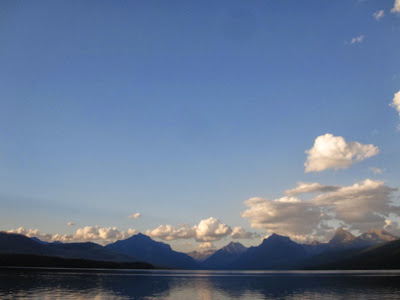 |
| Lake McDonald - Glacier National Park |
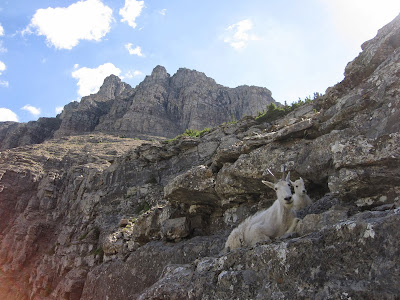 |
| Mountain goats. Glacier National Park. |
From Glacier we hopped back on the Amtrak to Portland. Two days there
putzing around then we flew up to Anchorage. We decided to splurge on a
rental car. In retrospect this was a necessity. Our trip would have
been very different without the freedom a car gives you.
 |
| And without a car we wouldn't have had the opportunity to drive on leopard roads! |
 |
| And in case you are lost in the woods. Okay, it was on the side of the road. |
I can't begin to explain how large Alaska is. It's cliche, I
know. Who cares. It's huge. We drove from Anchorage up to
Denali National Park. Two days we spent in these little cabins.
Quite nice. We drove up to the Park those days, got our bearings, did some
day hikes, and selected our campgrounds for the next few nights. We
settled on three nights at Igloo Creek. Camping turned out to be a
wonderfully economical way to enjoy the park. One Camper Bus ticket
allowed us unlimited rides on the buses for the entire time we were
camping. Had we have chosen not to camp we would have been stuck paying
thirty-some odd dollars a day to ride the bus.
Denali National Park is huge. Most people (including us) only get to
see a very small part of it. There is only one road in the park, and most
of that road is closed to the public. That's where the buses from above
come into play. Forcing visitors to use the buses cuts down significantly on traffic in the
park. It's a little annoying if you want to move at your own pace, but
it's pretty awesome if you want to see animals. From the bus we saw
caribou, sheep, fox, bear (finally), even a lone wolf one evening running off in the
distance. It's amazing how safe you feel observing the wildness of Alaska from within a metal walled bus. This changes dramatically when you see a bear and you are not in the bus anymore (this is a story for later). Hiking with the buses is also very convenient. When you want to get off and start a hike you simply signal the
driver. Without any officially maintained trails, this is theoretically
possible to do anywhere. In reality, there are more or less unofficial
trails that tend to earn reputations from other hikers or recommendations from
the bus drivers. We took advantage of the wisdom of others and took a few of these hikes.
 |
| Hiking - Alaska style. |
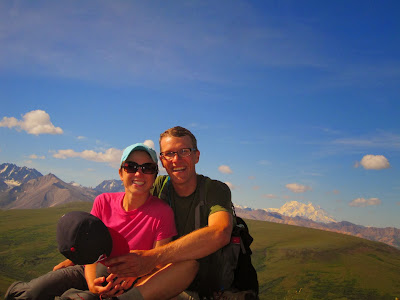 |
| "Ah! What a lovely couple!" - Kurt Jones circa 2011 |
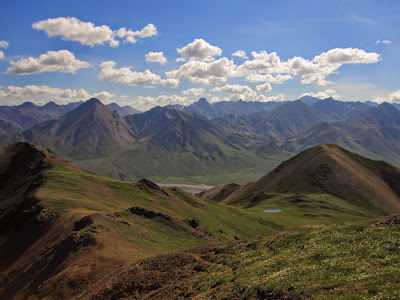 |
| Just some mountains. No big deal. |
After Denali we headed over to the bizarre hippy/middle-aged tourist
haven known as Talkeetna.
It was a weird
mix of awesome.
The thing about Alaska
is that it attracts well-to-do middle-aged couples (we met a 50-something newly
married couple on their honeymoon) seeking the Alaskan experience (gold
panning, salmon fishing, big game hunting) and at the same time it attracts
those of the younger generation with interests in the fields of hippie-dom,
alcohol fishing, and hitchhiking.
Imagine Duluth+San Francisco in 1969.
These two groups of people, along with the third group – the locals
(think the “keep it local and organic” crowd + the NRA’s most vocal advocates)
all intersect in Talkeetna.
The sum of
all of this is a large number of locally-owned shops, restaurants, and tour
companies staffed by scruffy looking gen-y’ers tending to every whim of the
baby-boomers’ desires.
We, like everyone
else we met or had talked to, loved Talkeetna.
 |
| Flight-seeing. So baller. |
From Talkeetna, we drove to Valdez.
A
small community ringed by massive mountains and the Pacific. Valdez is gorgeous. Valdez is a pretty
eerie place.
It is famous for its
catastrophes.
In 1964 the town was
demolished by the infamous Good Friday Earthquake.
The quake was the second largest recorded earthquake on
record (magnitude 9.2), and it caused a landslide-induced tsunami that swept away much
of the old town’s buildings.
Twenty-five
years later, again on Good Friday, the
Exxon
Valdez ran aground spilling oil just outside of the town polluting the
shoreline for miles and killing sea birds, mammals, and fish.
Despite these two events, Valdez is home to
the terminus of the Trans-Alaska oil pipeline.
We spent a few days bumming around Valdez before heading to Anchorage
and from their flying back to Tununak to start year five.
 |
| Popular dinner spot with the Valdez locals. We found the food to be overrated and underdone. |
 |
| The end of the line. Way up there on that hill. |
 |
| And you are definitely not allowed to visit. |
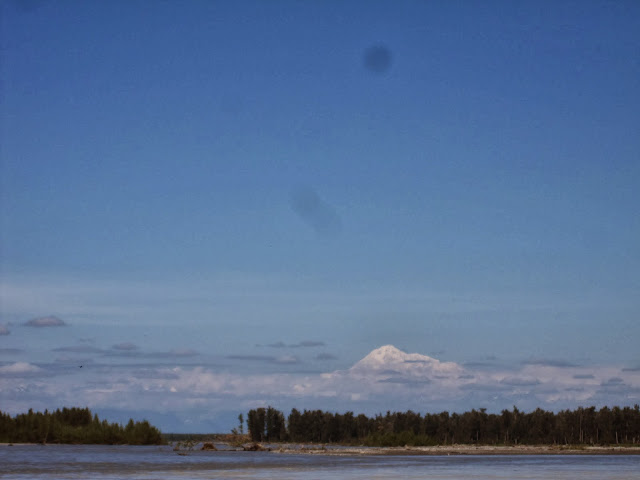 |
| Denali from Talkeetna. |